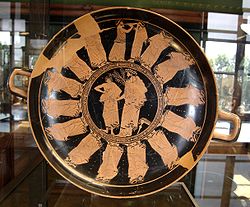
Triptolemos Painter
Encyclopedia


Ancient Greek
Ancient Greek is the stage of the Greek language in the periods spanning the times c. 9th–6th centuries BC, , c. 5th–4th centuries BC , and the c. 3rd century BC – 6th century AD of ancient Greece and the ancient world; being predated in the 2nd millennium BC by Mycenaean Greek...
vase painter, belonging to the Attic
Attica
Attica is a historical region of Greece, containing Athens, the current capital of Greece. The historical region is centered on the Attic peninsula, which projects into the Aegean Sea...
red-figure
Red-figure pottery
Red-figure vase painting is one of the most important styles of figural Greek vase painting. It developed in Athens around 530 BC and remained in use until the late 3rd century BC. It replaced the previously dominant style of Black-figure vase painting within a few decades...
style. He was active in Athens between 490 and 470 BC. His real name is not known. He started working in the workshop of Euphronios
Euphronios
Euphronios was an ancient Greek vase painter and potter, active in Athens in the late 6th and early 5th centuries BC. As part of the so-called "Pioneer Group,"...
, where he was probably taught by Douris
Douris (vase painter)
Douris was an ancient Athenian red-figure vase-painter and potter active ca. 500 to 460 BCE.-Work:He began his career painting for the potters Kleophrades and Euphronios, before beginning a long collaboration with the potter Python. He signed 39 vases as a painter, also one as a potter and...
. Later, he also worked for the potters Brygos, Hieron and Python. Initially, his style was strongly influenced by Archaic art. His later works are mediocre in quality. Nonetheless, his repertoire is broad, reaching from the Apaturia
Apaturia
Apaturia were Ancient Greek festivals held annually by all the Ionian towns, except Ephesus and Colophon. At Athens the Apaturia took place on the 11th, 12th and 13th days of the month Pyanepsion , on which occasion the various phratries, or clans, of Attica met to discuss their affairs.The name...
procession via erotic scenes and Theban scenes to the departure of Triptolemos (his name vase
Name vase
In classical archaeology, a name vase is a specific "vase" whose painter's name is unknown but whose workshop style has been identified. The painter is conventionally named after the selected "name vase" that embodies his characteristic style, or for one of its distinctive painted subjects, or for...
).

